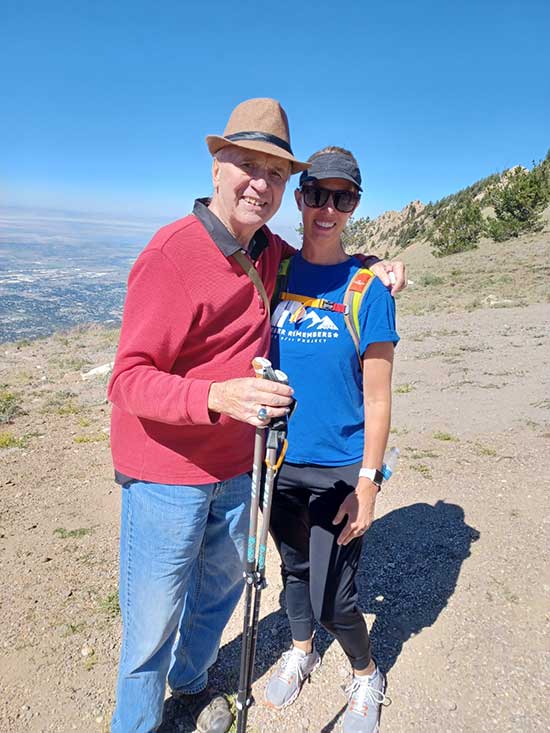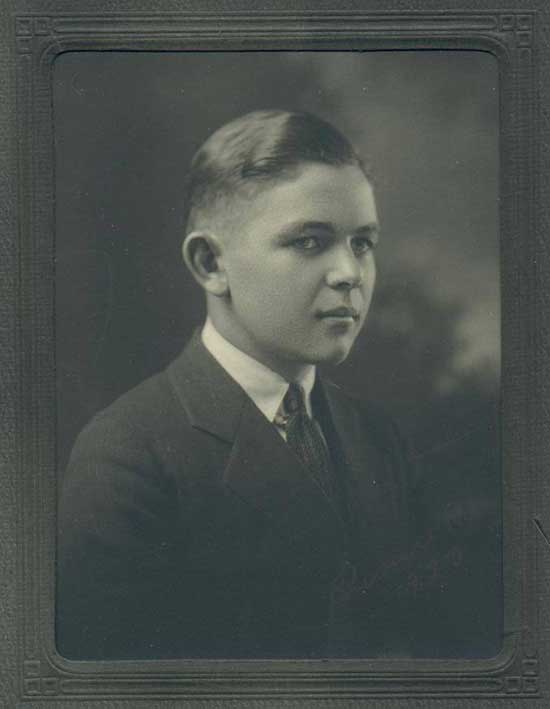Wildcat Inbox
Staying in touch with alumni and friends
This year, we celebrated 100 years since students and faculty joined then Weber president Aaron Tracy to plant a school flag on top of Mount Ogden. The hike has become a memory-making tradition for the WSU community. We asked readers for their hike stories.
A Helping Hand
The annual Weber State University hike to Mt. Ogden was held Sept. 24. It was to be the 100th anniversary of the hike. I got excited. I decided to go. After all, I had made the hike twice before. And this was my MCD, Minor Cognitive Dissonance, a common occurrence as you age with the blessing of ADHD. It goes like this, “Hell I’ve done that before, not a problem.” The dissonance occurs when you leave out the part that you are 81 years old now and the last time you were in your mid-teens. MCD occurs when your mental growth does not matriculate with your physical aging.
 So off to the Snowbasin parking lot I went. Following some entertainment, we were ready to go. I started with a group of people and soon began having a hard time keeping up. They encouraged me to go back, buy a ticket on the gondola and hike from the top of the ride.
So off to the Snowbasin parking lot I went. Following some entertainment, we were ready to go. I started with a group of people and soon began having a hard time keeping up. They encouraged me to go back, buy a ticket on the gondola and hike from the top of the ride.
I started my hike and soon found that it was further to the top than I remembered. As I began my hike, I again began to falter. It was harder than I thought. And this is where the real blessing of the hike began.
While faltering, a lady came up behind me. She had a choice. She could easily have simply passed me and continued her hike. But she was more perceptive and could see that I, an elderly man, possibly a “stud emeritus” needed help. She had a couple of hiking poles she was using, took them from her hands, and stuck them in mine. She didn’t ask, she just took charge and put them in my hands. I wasn’t sure if she was hard of hearing or just ignored me and had already diagnosed my plight — I was going to use her poles. She was a strong enough personality I wasn’t about to challenge her. So, I suppressed my pride and began to accept her help. Then for the next two hours of the hike to the top, she stayed behind me and every time I faltered, I felt a hand in my back and a gentle shove. Two hours!
I did get her name, not all of it—Lisa, missed her last name. And so for her hike to the top, it became a service project to get me to the top.
As I reflect on the experience, it is hard not to get emotional. A total stranger diagnosed a need and chose to fill that need. With all of the divisiveness in our world today there are still super people with such a deep sense of decency.
This writing is my attempt to share the decency of Lisa. Your help is so much more than getting me to the top of the mountain—it is a reinforcement that there are still great people in our society who put the needs of others over their own. Thank you, Lisa.
— Jack Magdiel AS ’62
Upon contacting hike organizers, we discovered that hiker Lisa Enz lent her hiking poles to Jack and stayed by his side during the climb.
Like Jack, she looks back fondly on the 2022 Mount Ogden Hike.
Hike Memories
Alum Ted Woolley BS ’74 shared photos of his father, Edwin Woolley ’23, having fun on the first Mount Ogden Hike, along with a history of Ed’s experience written by his niece, Laurel Cunningham.
“While Ed attended Weber Academy, he participated in the school’s first trek to the top of Mt. Ogden Peak. Ed and 365 other Weber Academy students hauled a 300-pound steel flagpole a vertical mile from the city below and planted it into the peak on October 4, 1922… Ed was the editor of Weber Academy’s school newspaper — Weber Herald.”
— Laurel Cunningham


Former hike leader and WSU professor Gary Willden sent us his photos taken at the saddle point just below the summit.

Willden with other hikers at the saddle point just below the summit, 2009

Willden on Mount Ogden with regular hike participant Ruth Orton, 2004
Reaching New Heights
Weber State’s influence extends across the world. Recently, professor Michael Wutz wrote about sharing his purple pride in Tanzania and Italy.
For the Weber State community, “Making the Climb” is synonymous with hiking Mount Ogden, where then-president Aaron Tracy planted a flag in October 1922. While WSU is celebrating the 100th anniversary of this tradition, I recently had the privilege of participating in two strenuous ascents, so to (s)peak, reminding me that the age-old image of climbing a mountain as a metaphor for hard work, while being almost clichéd, is no less truthful for all that.
 In December 2021, I hiked Mount Kilimanjaro in Tanzania together with our son Christian, a small group of fellow backpackers, and a team of porters and guides. Measuring 19,341 feet, Kilimanjaro is the highest mountain in Africa and highest single free-standing mountain in the world. While not Mount Qomolangma/Everest, which is for extreme alpinists only, Kilimanjaro is a popular destination for hikers looking for a dash of adventure and test of their physical limits. The hike, from lush rainforests to the climate zones of the Alpine Desert and the Arctic Summit, is not technical requiring specialized gear and expertise, but rather a, well, hike, albeit a strenuous one. In truth, the climb is doable by most everybody in good condition and attitude. (That being said, nearly 1,000 rescues and 10 deaths on the mountain occur each year.) “Pole Pole,” the Swahili phrase for “slowly, slowly,” was the refrain of our guides as we trudged upward, and our bodies registered the effects of the altitude. After six days along the so-called Lemosho route and a seven-hour midnight climb to the top — darkness has its blessings when you are huffing and puffing on what feels like infinite steepness — we finally reached Uhuru Peak, named for the Swahili word for “freedom.” (Trekkie fans may remember the word from the name of communications officer, Lieutenant Uhura). It was a sweet feeling mixed with tears of relief. We didn’t plant a flag, but Weber State was with us all the way.
In December 2021, I hiked Mount Kilimanjaro in Tanzania together with our son Christian, a small group of fellow backpackers, and a team of porters and guides. Measuring 19,341 feet, Kilimanjaro is the highest mountain in Africa and highest single free-standing mountain in the world. While not Mount Qomolangma/Everest, which is for extreme alpinists only, Kilimanjaro is a popular destination for hikers looking for a dash of adventure and test of their physical limits. The hike, from lush rainforests to the climate zones of the Alpine Desert and the Arctic Summit, is not technical requiring specialized gear and expertise, but rather a, well, hike, albeit a strenuous one. In truth, the climb is doable by most everybody in good condition and attitude. (That being said, nearly 1,000 rescues and 10 deaths on the mountain occur each year.) “Pole Pole,” the Swahili phrase for “slowly, slowly,” was the refrain of our guides as we trudged upward, and our bodies registered the effects of the altitude. After six days along the so-called Lemosho route and a seven-hour midnight climb to the top — darkness has its blessings when you are huffing and puffing on what feels like infinite steepness — we finally reached Uhuru Peak, named for the Swahili word for “freedom.” (Trekkie fans may remember the word from the name of communications officer, Lieutenant Uhura). It was a sweet feeling mixed with tears of relief. We didn’t plant a flag, but Weber State was with us all the way.
My second climb took place a short 10 days later, when I assumed a residency at the Bogliasco Foundation outside Genoa, Italy, there to work on a research project during my sabbatical. Nestled on the Ligurian Sea, with the southwestern flank of the Alps in the background, the hills of Bogliasco ascend right from the coastline and invite vigorous hiking as well. Cinque Terre, the legendary coastal strip connecting villages through a maze of trails, is a short train ride away as well and gives even the best conditioned trekkers a workout. My more strenuous day job, however, was working among a group of accomplished writers, composers, dancers and performance artists, who spurred me on to reach my peak, and represent WSU in the best possible way. Following the rules of the house, we had a scheduled cocktail hour — yes, you read that right! — most every evening and shared our work over dinner prepared by in-house chefs. The setting of the foundation’s home, the Villa dei Pini, on the edge of the Riviera, provided a front-seat window onto the Mediterranean, from where my nebulous thoughts crystallized, slowly, into some of the best writing I had ever done.
— Michael Wutz, Brady Presidential Distinguished Professor of English; Editor of Weber - The Contemporary West
Where have you traveled while representing Weber State? Want to share your thoughts on something you read? Email us at magazine@weber.edu.
